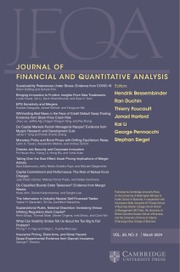No CrossRef data available.
Article contents
Attention Constraints and Financial Inclusion
Published online by Cambridge University Press: 23 January 2025
Abstract
We show that attention constraints on decision-makers create barriers to financial inclusion. Using administrative data on retail loan-screening processes, we find that attention-constrained loan officers exert less effort reviewing applicants of lower socioeconomic status (SES) and reject them more frequently. More importantly, when externally imposed increases in loan officers’ workloads tighten attention constraints, loan officers are even more prone to quickly reject low-SES applicants but quickly accept very high-SES applicants without careful review. Such selective attention allocation further widens the approval rate gap between high- and low-SES applicants—a unique prediction of this attention-based mechanism.
Information
- Type
- Research Article
- Information
- Creative Commons
- This is an Open Access article, distributed under the terms of the Creative Commons Attribution-NonCommercial-ShareAlike licence (http://creativecommons.org/licenses/by-nc-sa/4.0), which permits non-commercial re-use, distribution, and reproduction in any medium, provided the same Creative Commons licence is used to distribute the re-used or adapted article and the original article is properly cited. The written permission of Cambridge University Press must be obtained prior to any commercial use.
- Copyright
- © The Author(s), 2025. Published by Cambridge University Press on behalf of the Michael G. Foster School of Business, University of Washington
Footnotes
The authors appreciate feedback from Sumit Agarwal, Patrick Bayer, Tobias Berg, Douglas Bernheim, Phillip Bond, Patrick Button, Lynn Cornell-Price, Shaun Davies, Daniel Ferreira, Matthew Gentzkow, Troup Howard, Tingyan Jia, Timothy McQuade, Filip Matejka, Jonathan Parker, Wenlan Qian, and Alminas Zaldokas as well as participants at the AEA Discrimination and Disparities in Credit and Housing Markets Session, Colorado Leeds, Consumer Financial Protection Bureau Research Conference (6th), Econometric Society meetings (Asia+Australia+China+Africa), European Economic Association – European meeting of the Econometric Society Meeting, Great Bay Area Finance Conference, NBER Household Finance Working Group Meeting, China Financial Research Conference, Online Seminar on the Economics of Discrimination and Disparities, Utah Behavioral Lab, Utah Eccles, and Washington Foster. Hyun Joong Kim provided excellent research assistance. Authors are listed alphabetically and have contributed equally to this work.

